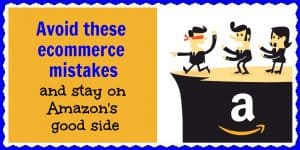I’ve always found Amazon to be pretty easy to work with. There are rules, though… and they are getting stricter about enforcing them.
With the holiday season getting into gear, now is NOT the time you want to risk getting into trouble with Amazon.
By far, the holiday season is the busiest and most lucrative time of year for businesses. And that’s why I decided to create a list of the most often cited mistakes ecommerce companies make with Amazon that can get them suspended, or even worse — banned.
Again, you generally don’t have to worry too much when dealing with Amazon. But it’s better to be safe than sorry, right?
I’d recommend taking a close look at the list of mistakes below to make sure your Amazon account and listings are all up to snuff.
That said, let’s dive into the top ways you can get onto Amazon’s bad side…
Late shipment rate
Have too many late or incorrect shipments can get you suspended or audited.
According to Seller Central, “The Late Shipment Rate (LSR) represents orders ship confirmed after the expected ship date as a percentage of total orders, over both a 10-day or a 30-day period. LSR only applies to seller-fulfilled orders…
Our policy is that sellers should maintain an LSR under 4% in order to sell on Amazon. An LSR above 4% may result in account deactivation.”
To view your LSR, follow these steps:
- Under the Performance tab, visit your Account Health page.
- Click Late Shipment Rate in the Shipping Performance column.
Make sure that your handling times are set generously, as it’s better to have peace of mind than a suspended account.
Pre-fulfillment cancel rate
This calculation refers to the number of orders cancelled by you, the seller, before the shipments are confirmed divided by the total number of orders received in a given time period.
Miscalculating the amount of inventory you have is usually the reason behind a high pre-fulfillment cancellation rate, which you want to keep below 2.5%.
(And for most LHS sellers, this won’t be an issue since you don’t have to worry about inventory.)
To view your pre-fulfillment cancel rate, follow these steps:
- Under the Performance tab, visit your Account Health page.
- Click Pre-fulfillment Cancel Rate in the Shipping Performance column.
Valid tracking rate
According to Amazon…
If you are a North American seller, “you are required to provide valid tracking numbers for 95% of your US shipments. The following items are not included in this calculation:
- Items shipped by freight with a carrier not integrated with Amazon.
- Small items (such as screen protectors and greeting cards) that cost less than $10 (including shipping charges) and are shipped in USPS Standard Mail envelopes or First Class Mail envelopes.
If you don’t meet the 95% target in a specific category, you risk losing your ability to sell non-FBA (Fulfillment by Amazon) items within that category.”
And if you are an international seller, “Where Amazon integrated tracking solutions are available (such as China Post Express and Logistic ePacket service), [Amazon] require[s] valid tracking numbers for at least 95% of your shipments on orders greater than $5.00 (with shipping).
If you sell fast-moving, small, and light products that are generally priced under $10, you might consider FBA Small and Light program. This program offers lower fulfillment costs and Amazon will fulfill the orders for you. Learn more about this program.”
To view your valid tracking rate, follow these steps:
- Under the Performance tab, visit your Account Health page.
- Click Valid Tracking Rate in the Shipping Performance column.
Order defect rate
Your order defect rate (ODR) factors in the percentage of orders that receive the following:
- Negative feedback (1- or 2-star ratings)
- an A-to-Z claim
- chargebacks
Negative feedback rate – If have too much bad feedback in terms of your products’ quality, inaccurate information, delivery issues, or poor customer service, you can have your account suspended or audited.
A-to-Z Guarantee claim rate – Filing an A-to-Z claim against you is usually a customer’s last resort. And so, if you have too many customers using this path to return items or to get refunds, that can also be grounds for suspension.
Credit Card Chargeback rate – A chargeback occurs when customers dispute their orders as a credit card purchase. So if you have too many of these, that’s another reason you can be suspended.
You should aim to have an ODR rate that’s less than 1%.
To view your ODR, follow these steps:
- Under the Performance tab, visit your Account Health page.
- Click Order Defect Rate in the Customer Service Performance column.
Including external links
A lot of Amazon sellers, myself included, sell their products on other platforms or they have their own websites. And sometimes, sellers will promote these other platforms or websites on Amazon by including external links.
Whether these links are added to your products’ listings or included in your communications with customers, it’s a no-no with Amazon that can get your account put under review. Additionally, you cannot watermark any of your images with external links.
Duplicate ASIN and product pages
Amazon has a strict no duplicates policy. So if you list the same product under multiple ASINs or on multiple product pages, your account can be suspended.
Similarly, you can also be suspended for opening multiple seller accounts, unless Amazon has expressly given you permission to do so.
Selling unauthorized items
Unauthorized items can occur in a few forms:
Counterfeit – Common counterfeit or imitated items include DVDs, movies, and beauty and skincare products. If you sell any of these types of things, make sure everything is authentic.
Rights infringement – Any item that’s registered under another brand name or has another brand’s slogan or trademark constitutes rights infringement and can get you banned.
Restricted – Amazon has a list of items sellers are restricted from selling. Here is that list (click the links to learn more details about the restrictions):
- Alcohol
- Animals & Animal Products
- Art – Fine Art
- Art – Home Decor
- Automotive and Powersports
- Composite Wood Products
- Cosmetics & Skin/Hair Care
- Currency, Coins, Cash Equivalents, and Gift Cards
- Dietary Supplements
- Drugs & drug paraphernalia
- Electronics
- Explosives, Weapons, and Related Items
- Export Controls
- Food & Beverage
- Gambling & Lottery
- Hazardous and Dangerous Items
- Human Parts & Burial Artifacts
- Jewelry & Precious Gems
- Laser products
- Lighting
- Lock Picking & Theft Devices
- Medical devices and accessories
- Offensive and Controversial Materials
- Pesticides
- Plants, Plant Products, and Seeds
- Postage Meters & Stamps
- FBA Prohibited Products exceptions
- Recalled Products
- Recycling electronics
- Sex & Sensuality
- Subscriptions and Periodicals
- Surveillance Equipment
- Tobacco & Tobacco-Related Products
- Warranties, Service Plans, Contracts, and Guarantees
False advertising or unsubstantiated claims
If Amazon becomes aware that you’ve provided inaccurate or false information about a product (e.g. false info about pricing, the manufacturer, or freight and logistical costs), you can get suspended or put under audit.
You can also get into trouble for trying to pass used items off as new. Always double check your products’ listings for accuracy.
Fake reviews or offering compensation
It’s understandable to want lots of positive reviews and few to zero negative reviews. If you do get negative reviews, though, don’t offer to compensate people with money or free merchandise for removing or altering their reviews. There are other means of accomplishing this goal.
A while back, I wrote a post about the right way to fight back against negative feedback. You can check it out here.
You also don’t want to buy positive reviews. Amazon takes the integrity of reviews seriously, so abusing the reviewing system is an easy way to get suspended.
Here’s what to do if your account is suspended
(NOTE: We’re talking about being suspended here. If your account gets banned, you, unfortunately, don’t have any recourse. But if your account is only suspended, you do have a chance to appeal.)
If your Amazon account gets suspended, you have 17 days to submit an appeal. Here are the steps you should take:
First, you need to find out why your account was suspended. To do that, check your Performance Notifications in Seller Central.
You should have received a notification with the subject “Your Amazon.com selling privileges have been removed.” The message should include a list of all the ASINs that in some way violate Amazon’s policies. Plus, it should include a link where you can submit your appeal.
There are three basic reasons Amazon stipulates for suspending an account:
- Performance issues – Under the Performance tab, check your Account Health Dashboard where you can see which metrics aren’t doing well (e.g. negative feedback, A-to-Z Guarantee claims, chargeback claims, late shipment rate, pre-fulfillment cancel rate).
- Seller policy violations – Your selling practices need to be in line with Amazon’s community rules, which you can review here.
- Product rule violations – Amazon should note the specific prohibited item(s) in their notice. But if not, you should review your inventory and inventory intake process to assess which items need to be removed.
Then, Amazon expects you to create a Plan of Action based on what the notification says the issues are and how you plan to remedy the situation.
Here are some tips for writing an effective Plan of Action:
- Be as precise and clear as possible when detailing your solution suggestions.
- Be brief. You want to convey all the necessary details but in a way that’s to the point and concise.
- Don’t be overly emotional or defensive. Avoid the temptation to prove you’ve been falsely accused. Amazon has already seemed you responsible, so your best bet is to accept that and be objective and stay on message.
To learn more about the appeal process, click the Help tab in Seller Central and search “Appeal the restriction or removal of selling privileges.”
Or, to see how Amazon suggests dealing with specific suspension reasons, search “Create a plan of action to reinstate selling privileges.”
Here’s a basic Plan of Action template you can follow:
Dear Amazon Performance Seller Team,
Thank you for allowing me to appeal my Amazon seller suspension. Below, you’ll find my Plan of Action for resolving [the reason for your suspension according to Amazon].
The following issues have been identified to me:
[Issue 1]
[Issue 2]
[Issue 3]
[And so on]
Here’s how I plan to remedy these issues:
[Solution to issue 1]
[Solution to issue 2]
[Solution to issue 3]
[And so on]
Thank you again for reviewing my appeal. I look forward to your response.
Best,
[Your name]
What do you think of this list of ecommerce mistakes? Has anything ever happened to your Amazon account? If so, how did you handle the situation? Please leave a comment below and share your insights and experiences!

?




